1. Introduction of DSM-036 BLE WiFi Module
DSM-036 Bluetooth WiFi module is an Internet of Things wireless module with a stamp hole interface designed based on embedded Wi-Fi6 +BLE SoC chip ECR6600. It includes PCB onboard antenna and IPEX seat. In addition to this, It has a small size and rich interfaces, easy to develop.
This model specification describes DSM-036 WiFi and Bluetooth module’s physical characteristics, technical specifications, communication protocol, product functions, performance, and other technical standards.
- MCU Frequency 240MHz
- True Random number generator
- RAM maps directly to the data
- Peripherals: UART 0/1/2, SPIO(80MHz max), I2C Controller, I2S Controller, SDI02.0(50MHz max), PWMx5, ADC*3
- Working voltage: 3.0 V to 3.6 V
- Wi-Fi Performance
Support Full MAC (LMAC+UMAC)
Single Frequency 2.4G IEEE 802.11 b/g/n/ax
Support Greenfield mode, Mixed-mode, and Legacy mode
Soft-AP, STA
Support RX, STBC
Built-in PA, LNA, TRX Switch
All GI, TWT
Dynamic bandwidth management - BLE Performance
BLE 5.1
Support BLE and BT multi-device connection
iShare PA&LNA with Wi-Fi
GAP
Supporting Adaptive Frequency Hopping(AFH) - Certification CE, FCC, SRRC
- Supporting Firmware OTA
- Supporting connection parameter update
- Smart Apartment
- IoT and Big data transmission
- Electrician, Lighting, and Door Lock
- Wearable Devices and IoT Remote Monitoring Device
- Battery IPC
- POS
- Home Appliances/ Home Entertainment/ Wi-Fi Toys
2. Mechanical Requirement of DSM-036 WiFi BLE Module
Dimensions: 18±0.35 mm (W) x33 ±0.35 mm (L) x 3.0±0.15 mm (H).
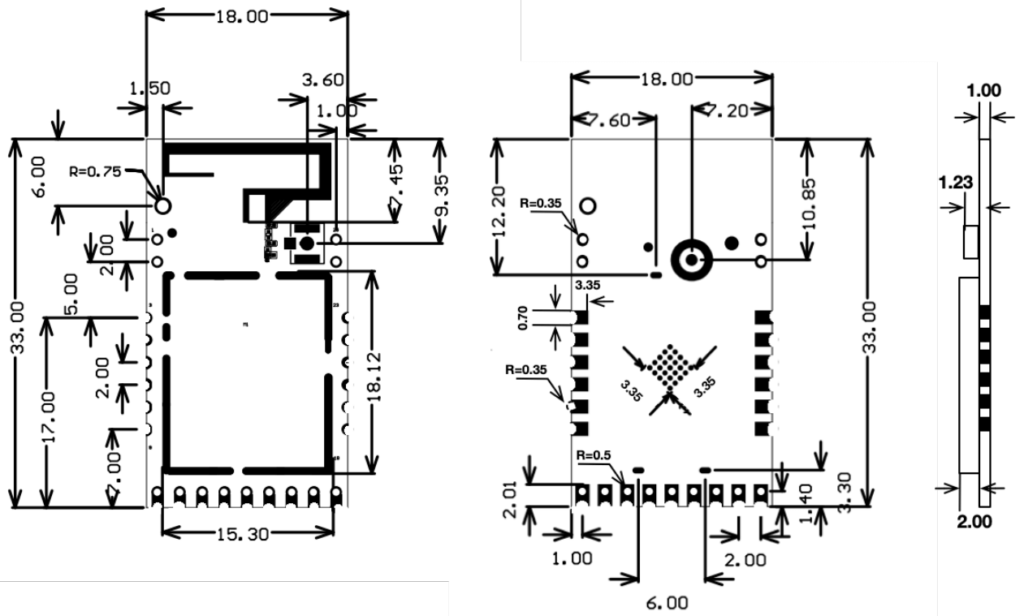
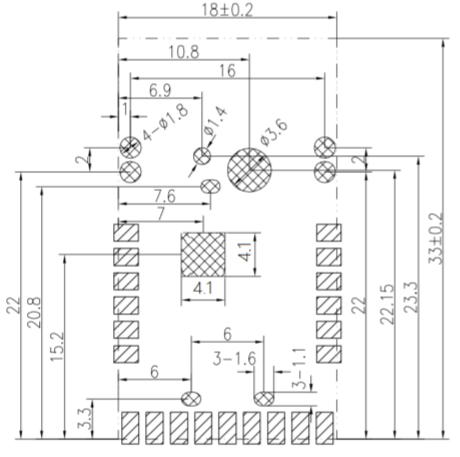
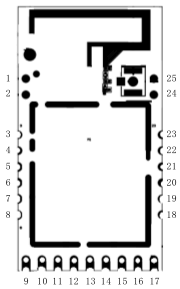
| Pin Number | Pin Name | IO Type | Main Function (After Reset) | Alternate Function |
|---|---|---|---|---|
| 1,3 | GPIO14 | I | GPIO14 | BOOTMODE0/AUX_0/VOUT_QP/PWM_CTRL4/I2S_TXD |
| 2,4 | GPIO15 | I | GPIO15 | BOOTMODE1/AUX_1/VOUT_QN/PWM_CTRL5/I2S_TXWS |
| 5 | GPIO20 | I | GPIO20 | PWM_CTRL3/AUX_2/VOUT_IP/I2S_MCLK |
| 6 | GPIO16 | I/O | GPIO16 | UART1_CTS/ IR_OUT/PWM_CTRL2 |
| 7 | GPIO17 | I/O | GPIO17 | UART2_RXD/PWM_CTRL5/SPI1_WP/I2S_TXWS |
| 8 | GPIO13 | I/O | GPIO13 | UART2_TXD/I2C_SCL/I2S_RXD/dpll_80M_o |
| 9 | GPIO22 | I/O | GPIO22 | UART0_TXD/PWM_CTRL0/I2S_TXWS |
| 10 | GPIO21 | I/O | GPIO21 | UART0_RXD/I2C_SDA/I2S_TXD |
| 11 | Chip_EN | P | Chip_EN | 0=DEF mode;1=test mode |
| 12 | GPIO23 | I/O | GPIO23 | UART1_RTS/PWM_CTRL1/I2S_TXSCK |
| 13 | GPIO25 | I/O | GPIO25 | phy_entrx/PWM_CTRL3/!phy_entrx/I2C_SDA |
| 14 | GPIO24 | IO | GPIO24 | UART1_CTS/ PWM_CTRL2/ I2S_MCLK |
| 15 | GPIO6 | I/O | GPIO6 | UART0_TXD/32K_CLK_OUT/XTAL_O_32k/I2S_RXSCK/COLD_RESET |
| 16 | VDD | P | VDD | |
| 17 | GND | P | GND | |
| 18 | GPIO5 | I/O | GPIO5 | UART0_RXD/40M_CLK_OUT/XTAL_I_32k/I2S_RXWS/IR_OUT |
| 19 | GPIO4 | I/O | GPIO4 | UART0_RTS/PWM_CTRL4/SPI1_CS1/MSPI_CS1 |
| 20 | GPIO3 | I/O | GPIO3 | UART0_CTS/PWM_CTRL3/SPI1_MISO/I2C_SDA |
| 21,24 | GPIO2 | I/O | GPIO2 | UART1_TXD/PWM_CTRL2/SPI1_MOSI/I2C_SCL |
| 22,25 | GPIO1 | I/O | GPIO1 | UART1_RXD/PWM_CTRL1/SPI1_CS0/I2S_RXD |
| 23 | GPIO0 | I/O | GPIO0 | UART2_TXD/PWM_CTRL0/SPI1_CLK/I2S_TXSCK |
•P indicates power supply pins, I/O indicates input/output pins
3. Electrical Parameters of DSM-036 WiFi Bluetooth Combo Module
| Parameter | Description | Typical value | Minimum value | Maximum value | Unit |
|---|---|---|---|---|---|
| Ts | Storage temperature | -40 | 125 | ℃ | |
| VCC | Power supply voltage | 2.2 | 3.8 | V | |
| Static electricity voltage (human body model) | TAMB-25℃ | - | 2 | KV | |
| Static electricity voltage (machine model) | TAMB-25℃ | - | 0.5 | KV |
| Parameter | Description | Minimum value | Maximum value | Typical Value | Unit |
|---|---|---|---|---|---|
| Ta | Working temperature | -40 | 105 | - | ℃ |
| VCC | Power supply voltage | 2.0 | 3.6 | 3.3 | V |
| VIL | I/O low-level input | - | I0VDD*0.3 | V | |
| VIH | I/O high-level input | I0VDD*0.7 | - | - | V |
| VOL | I/O low-level output | - | I0VDD*0.2 | - | V |
| VOH | I/O high-level output | I0VDD*0.8 | - | - | V |
| Isl | Sleeping Current | - | 6.5 | - | uA |
4. Wi-Fi Performance of DSM-036 WiFi BT Module
Test conditions: 3.3V power supply, launch test at 50% duty cycle.
| Parameters | Typ. | Unit |
|---|---|---|
| 11b 1Mbps POUT = +20dBm (Transmit) | 343 | mA |
| 11b 11Mbps POUT = +20dBm(Transmit) | 335 | mA |
| 11g 6Mbps POUT = +19dBm (Transmit) | 255 | mA |
| 11g 54Mbps POUT = +17dBm (Transmit) | 205 | mA |
| 11n HT20 MCS0 POUT = +19dBm (Transmit) | 246 | mA |
| 11n HT20 MCS7 POUT = +16dBm (Transmit) | 206 | mA |
| 11ax HT20 MCS0 POUT = +19dBm (Transmit) | 250 | mA |
| 11ax HT20 MCS7 POUT = +16dBm (Transmit) | 205 | mA |
| 11n HT40 MCS0 POUT = +18dBm (Transmit) | 230 | mA |
| 11n HT40 MCS7 POUT = +15dBm (Transmit) | 188 | mA |
| Wi-Fi Receive | 34.8 | mA |
| Parameters | Rate | Standard (dBm) | CH1 | CH7 | CH13 | Unit |
|---|---|---|---|---|---|---|
| Output power | 11b, 1Mbps | 20±1dBm,EVM<-20dB | 20.63 | 20.18 | 20.49 | dBm |
| 11b,11Mbps | 20±1dBm, EVM<-20dB | 20.63 | 20.2 | 20.5 | dBm | |
| 11g , 6Mbp | 19±1dBm,EVM<-28dB | 19.18 | 19.22 | 19.29 | dBm | |
| 11g , 54Mbps | 17±1dBm,EVM<-28dB | 17.23 | 17.21 | 17.14 | dBm | |
| 11n, HT20 MCS0 | 19±1dBm,EVM<-29dB | 18.64 | 18.69 | 18.67 | dBm | |
| 11n, HT20 MCS7 | 16±1dBm,EVM<-29dB | 16.3 | 16.13 | 16.24 | dBm | |
| 11ax ,HT20 MSC0 | 19±1dBm,EVM<-32dB | 18.91 | 18.81 | 18.88 | dBm | |
| 11ax ,HT20 MSC7 | 16±1dBm,EVM<-32dB | 16.22 | 16.02 | 16.15 | dBm | |
| Rate | Standard (dBm) | CH3 | CH7 | CH11 | Unit | |
| 11n, HT40 MCS7 | 17±1dB,EVM<-29dB | 17.21 | 17.22 | 17.34 | dBm | |
| 11n, HT40 MCS7 | 15±1dB,EVM<-29dB | 15.05 | 14.74 | 14.72 | dBm |
| Parameters | Test item | CH1 | CH7 | CH13 | Unit |
|---|---|---|---|---|---|
| Receive sensitivity | 11b, 1M , <-70dBm@8%PER | -94 | -94 | -94 | dBm |
| 11b, 11M ,<-70dBm@8%PER | -86 | -86 | -86 | dBm | |
| 11g, 6M , <-70dBm@8%PER | -90 | -90 | -88 | dBm | |
| 11g, 54M , <-70dBm@8%PER | -74 | -74 | -73 | dBm | |
| 11n, HT20 MCS0, <-70dBm@8%PER | -90 | -90 | -89 | dBm | |
| 11n, HT20 MCS7, <-70dBm@8%PER | -71 | -71 | -70 | dBm | |
| 11ax, HT20 MCS0, <-70dBm@8%PER | -89 | -89 | -88 | dBm | |
| 11ax, HT20 MCS7, <-70dBm@8%PER | -71 | -71 | -70 | dBm | |
| Test item | CH1 | CH7 | CH13 | Unit | |
| 11n, HT40 MCS0,<-70dBm@8%PER | -87 | -87 | -87 | dBm | |
| 11n, HT40 MCS7,<-70dBm@8%PER | -68 | -68 | -68 | dBm |
5. BT/BLE Performance of DSM-036 BLE WiFi Module
| Parameters | Test Item | Standard(dBm) | Channel(dBm) | Unit | ||
|---|---|---|---|---|---|---|
| CH0 | CH19 | CH39 | ||||
| Output power | 1Mbps | 12±1 | 11.68 | 12.41 | 12.07 | dBm |
| 2Mbps | 12±1 | 11.83 | 12.46 | 12.11 | dBm | |
| Parameters | Test Item | Standard(dBm) | Channel(dBm) | Unit | ||
|---|---|---|---|---|---|---|
| CH0 | CH19 | CH39 | ||||
| Sensitivity>30% packet | 1Mbps | -70 | -92 | -92 | -92 | dBm |
| 2Mbps | -70 | -90 | -90 | -90 | dBm | |
6 Antenna of DSM-036 WiFi BLE Combo Module
This product uses an onboard PCB antenna.
To ensure optimal RF performance, it is recommended that the antenna be at least 15 mm away from other metal parts. If metal materials are wrapped around the antenna, the wireless signals will be reduced greatly, deteriorating the RF performance.
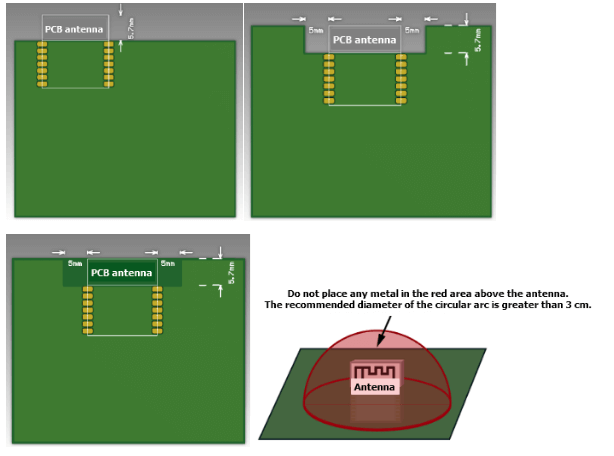
7. Instructions of DSM-036 WiFi and Bluetooth Module
1.Use an SMT placement machine to mount components to the stamp hole module that DUSUN produces within 24 hours after the module is unpacked and the firmware is burned. If not, vacuum packs the module again. Bake the module before mounting components to the module.
- SMT placement equipment:
Reflow soldering machine
Automated optical inspection (AOI) equipment
Nozzle with a 6 mm to 8 mm diameter - Baking equipment:
Cabinet oven
Anti-static heat-resistant trays
Anti-static heat-resistant gloves
2.Storage conditions for a delivered module are as follows:
- The moisture-proof bag is placed in an environment where the temperature is below 30℃ and the relative humidity is lower than 70%.
- The shelf life of a dry-packaged product is six months from the date when the product is packaged and sealed.
- The package contains a humidity indicator card (HIC).
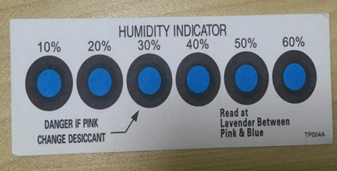
3.Bake a module based on HIC status as follows when you unpack the module package:
- If the 30%, 40%, and 50% circles are blue, bake the module for 2 consecutive hours.
- If the 30% circle is pink, bake the module for 4 consecutive hours.
- If the 30% and 40% circles are pink, bake the module for 6 consecutive hours.
- If the 30%, 40%, and 50% circles are pink, bake the module for 12 consecutive hours.
4.Baking settings:
- Baking temperature: 125±5℃
- Alarm temperature: 130℃
- SMT placement ready temperature after natural cooling: < 36℃
- Number of drying times: 1
- Rebaking condition: The module is not soldered within 12 hours after baking.
5.Do not use SMT to process modules that have been unpacked for over three months.
Electroless nickel immersion gold (ENIG) is used for the PCBs. If the solder pads are exposed to the air for over three months, they will be oxidized severely and dry joints or solder skips may occur. Roombanker is not liable for such problems and consequences.
6.Before SMT placement, take electrostatic discharge (ESD) protective measures.
7.To reduce the reflow defect rate, draw 10% of the products for visual inspection and AOI before first SMT placement to determine a proper oven temperature and component placement method. Draw 5 to 10 modules every hour from subsequent batches for visual inspection and AOI.
Perform SMT placement based on the following reflow oven temperature curve. The highest temperature is 245℃.
Based on the IPC/JEDEC standard, perform reflow soldering on a module at most twice.
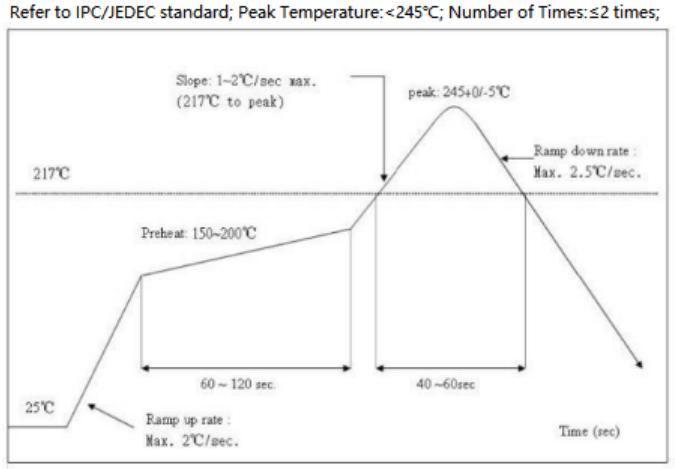
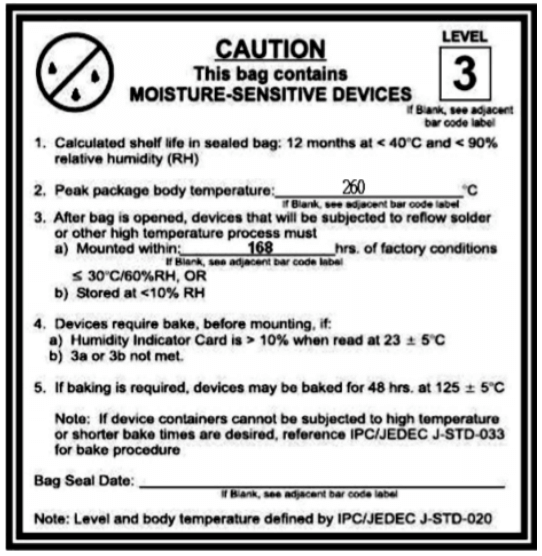
8. MOQ and Packing of DSM-036 Bluetooth WiFi Module
| Product model | MOQ(pcs) | Packing method | Number of Modules in each reel pack | Number of reel packs in each box |
|---|---|---|---|---|
| DSM-036 | 4000 | Carrier tape and reel packing | 1000 | 4 |















